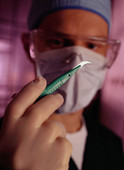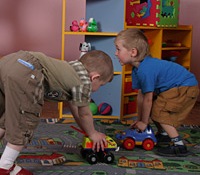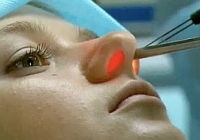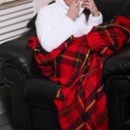The child is tied to the chair ropes, keep their head, open the mouth, enter the knife and... Blood, pain. This is an operation to remove adenoid. Although there are no civilized methods of surgical treatment for a long time, children continue to remove adenoids in such a barbaric way. As it happens?
Content
 Some she gives a lot of problems. Although initially intended to protect. Nasopharynk almond, or adenoid, keeps the first line of defense against microbes - those that seek to penetrate the body with air inhaled through the nose. On their way just the peculiar filter in the form of adenoids. There are special cells (lymphocytes), which are neutralizing microorganisms.
Some she gives a lot of problems. Although initially intended to protect. Nasopharynk almond, or adenoid, keeps the first line of defense against microbes - those that seek to penetrate the body with air inhaled through the nose. On their way just the peculiar filter in the form of adenoids. There are special cells (lymphocytes), which are neutralizing microorganisms.
This troubled organ reacts to any inflammation. During the disease, adenoids increase. When the inflammatory process passes, returned to normal condition. If the gap between diseases is too short (week and less), adenoids do not have time to decrease, they are constantly inflamed.
Such a mechanism («all the time do not have time») leads to the fact that adenoids grow even more. Sometimes they «Wake up» to such an extent that almost completely overlap the nasopharynk. The consequences are obvious - the difficulty of nasal respiration and a hearing impairment. If you do not stop them on time, adenoids can cause changes in the face form, bite, blood composition, curvature of the spine, speech disorders, kidney incontinence, urinary incontinence.
Adenoids are delivered, as a rule, children. In adolescence (13-14 years), adenoid tissue decreases independently to minor sizes and life does not complicate. If from the very beginning to the problem arising from the professionally. Usually errors begin with the moment of diagnosis.
The reason for the wrong diagnosis can be like excessive self-confidence of the ENT doctor (a child entered the office, his mouth is open: «Ah, everything is clear, these are adenoids. Operation!») and lack of knowledge. In that the child does not breathe a nose, adenoids are not always to blame. The reason can be allergic and vasomotor rhinitis, curvature of the nasal partition, even a tumor. Of course, an experienced doctor can determine the degree of disease for pronunciation, voice timbre, speech beaches. But it is impossible to hope.
A reliable picture of the disease can be obtained only after the child survey. The most ancient way to diagnose, which, however, is most often used in children's clinics, is a finger study. Separate with your fingers in the nasopharynx and feel the almond. The procedure is very painful and subjective. One finger is like that, and another - such. One climbed: «Yes, adenoids». And the other did not spoke anything: «Well, there are no adenoids there». The child sits all in tears, and then he will not open another doctor to another doctor - it hurts.
Unpleasant and rear rososcopy method - «Shining» The mirror is deeply in the oral cavity (children have a call for vomiting). The diagnosis is again put on the basis of the nasopharynx x-ray, which allows us to find out only the degree of increasing adenoids and does not provide ideas about the nature of their inflammation and relationship with neighboring important structures in the nasopharynk, which in no case cannot be damaged during operation. So it was possible to make 30-40 years ago.
Modern methods are painless and allow to establish with high accuracy, what size of the adenoid and whether they need surgical treatment. It can be computed tomography or endoscopy. A tube (endoscope) connected to the camcorder is introduced into the nasal cavity. As the tube is promoted, everything is displayed on the monitor «Secret» Plots of nose and nasopharynx.
The adenoids themselves can be misled. Common Situation. When mom and child comes to a doctor? Usually a week after the disease: «Doctor, we do not get out of «Hospital»! Every month we have conjunctivitis, then otitis, then angrint, then sinusitis». In the clinic take pictures: adenoids are increased. (Which is natural during the inflammatory process!) Write: operation. And 2-3 weeks after the disease, if the child does not pick up a new infection, adenoids come to normal. Therefore, if in the clinic you were told that the child's adenoids, and they must be removed, think about consulting from another doctor. The diagnosis may not be confirmed.
Distinguish 3 degrees of adenoid development, and only 3rd is considered undoubted pathology. In the early stages of the disease, conservative methods are effective: homeopathy, laser therapy, cryotherapy (cold treatment), antibiotics. If the therapy does not help, the question arises about the operation.
In domestic medicine, this approach is often practiced: «Cut, and then let's see». Trees treated. Adenoids? So, surgery. Of course, you can treat conservative. And if it does not give the result? Still have to operate. So better right. Adenoids are mercilessly removed. Delete simply so in no case can neither adenoids nor appendix nor other useful things.
Another common mistake: if you remove adenoids, then the child will not hurt anymore. It is not true. Indeed, the almond inflamed is a serious focus of infection. Therefore, neighboring organs and tissues are also in danger - there can be easily moving microbes. But you can not cut off the infection. She is all equal «Get out» In another place: in the apparent sinuses, in the ear, in the nose.
The infection can be detected, identify, to make analyzes, determine sensitivity to drugs and only then assign treatment with a greater share of the probability that the disease will be defeated. Remove adenoids not because the child is sick. But only when they make nasal breathing make it difficult to complications in the form of sinusites, sinusites, otites.
Children with severe allergic diseases, especially with bronchial asthma, operation is often contraindicated. The removal of nasopharynten almond can lead to a deterioration in the state and exacerbation of the disease. So they are treated conservative.
 Of course, adenoids are not a deadly disease, no one has died. But there are situations where the operation is necessary. In the case of adenoids of the 3rd degree, when in fact the entire nasophack is closed almond, the child does not breathe at all, homeopathy will hardly help. By duration of adenotomy - one of the shortest operation. Lasts only 15-20 minutes, and the process itself «Cutting» - 2-3 minutes. In the nasophal, the knife in the form of a ring (adenota of the becman) is started, adenoid tissue is captured and cut off with one movement.
Of course, adenoids are not a deadly disease, no one has died. But there are situations where the operation is necessary. In the case of adenoids of the 3rd degree, when in fact the entire nasophack is closed almond, the child does not breathe at all, homeopathy will hardly help. By duration of adenotomy - one of the shortest operation. Lasts only 15-20 minutes, and the process itself «Cutting» - 2-3 minutes. In the nasophal, the knife in the form of a ring (adenota of the becman) is started, adenoid tissue is captured and cut off with one movement.
After the operation, children can lead a normal lifestyle, except that in the first day or two is preferably not very ride. The most important thing is not to overheat the child, do not feed solid and hot food so that it does not provoke bleeding. For its prevention, Vitamin K is usually prescribed.
The operation is not relieved technically, and many ENT doctors consider it a simple and banal procedure. Nevertheless, relapses (re-expanding adenoids) often occur. According to different sources, it is from 17 to 72% of cases. The reason most often is one: the surgeon did not completely remove adenoid fabric, left pieces. Not because «Hand shivered» (although these operations most often trust young inexperienced doctors, ordinators), just the doctor does not see what he does.
The knife starts behind the sky curtain, and further all manipulations are held on the touch. Approximately the same as if the surgeon was sewn wound or cut out appendicitis with closed eyes. Even the most experienced doctor will not be able to guarantee one hundred percent result. There are no cases when the child has to carry the operation more than once. Polisture Methodology itself.
Abroad, as they do in clinics - sat down, tied, jerked, with lidocaine, with tears, with blood, with impressions for life, - do not make it from the mid-80s of the last century!
Endoscopic surgery applies to the number of modern methods. The operation is carried out using tiny cameras. Everything that happens in the nasopharynk, the doctor sees on the monitor. This allows you to completely remove adenoid fabric, avoid bleeding and complications during operation. The first in our country (since 1995), such operations in children began to fulfill. G. Z. Piskunov in the Central Bank of MC Management of the President of the Russian Federation and prof. IN. WITH. Kozlov in the center of microendoscopic otorinolaryngology in Yaroslavl.
In the West «gold» Standard is an endoscopy, computed tomography plus surgery under general anesthesia. We have words «general anesthesia» cause immediately «Square» eyes. Of course, it would be wrong to say that anesthesia is absolute safety. But if you compare what is more dangerous - an operation with anesthesia or without anesthesia, "will translate the latter. Local painkillers act only on the mucous membrane.
During the operation, the child hurts. He shouts, twitching, no matter how tied. And the surgeon with their tool can seriously harm. Frequent complications such as scalping the rear wall of the throat when they cut a small tongue, mild sky injuries, damage to hearing pipes. Type of blood, pain, horror that the child is experiencing, reflected on the psyche. In children operated on without anesthesia, night incontinence of urine, ticks, stuttering. In general, they were continued to be treated on, only other doctors.
Anesthesia affects the quality of the operation. Under the anesthesia, the child does not hurt, it does not resist, and the surgeon can carefully remove adenoid fabric. Therefore, whatever they do, during any surgical manipulation, consciousness must be turned off. The child should not be present on his operation - it's taboo. Properly performed anesthesia does not cause complications. And local anesthesia is possible only when there is no experienced anesthesiologist and good apparatus.
 The surest way of prevention is not to meet with infection. And its main source among children is kindergarten. Easy mechanism. Child comes for the first time in kindergarten. Still never sick and communicated with two children in the nearest sandbox. And in the garden is a large company of peers: toys and pencils lick, spoons, plates, linen - all common. And there will always be one or two children who have snots hang to a belt that parents in the garden «shoved» not because the child should develop, contact with children, but because they need to work.
The surest way of prevention is not to meet with infection. And its main source among children is kindergarten. Easy mechanism. Child comes for the first time in kindergarten. Still never sick and communicated with two children in the nearest sandbox. And in the garden is a large company of peers: toys and pencils lick, spoons, plates, linen - all common. And there will always be one or two children who have snots hang to a belt that parents in the garden «shoved» not because the child should develop, contact with children, but because they need to work.
There were no two weeks as the newcomer Zalemog, stuck, shed, stiffed (up to 39). The doctor from the clinic looked the throat, wrote «ORVI (ORZ)», prescribed an antibiotic that he likes. What he will act on this infection, this is still a grandmother. She said - Microbes now sustainable. And in a situation where the child of the ARZ is not necessarily immediately «sculpt» His antibiotic.
It is possible that his immune system, first having met infection, will cope with it itself. Nevertheless, the child gives an antibiotic. Mom seven days with a child served - and to the doctor: «No temperature? So, health!». Mom - to work, baby - in the garden. That's just not recovering children in a week! For this you need at least 10-14 days. And the child returned to the team, brought with him a habitant infection and presented to everyone who could. And he himself picked up a new one. Against the background of an antibiotic and immunity disease, this happens very often. There is chronic inflammation.
We have many doctors, so many opinions. One says: Remove adenoids, and everything will be fine. Another advises to treat conservatively, in no case delete, because they will grow again. How to figure it out? Feel free to ask questions to the doctor and do not worry that you hurt your questions. Something did not understand - ask to explain.
If the doctor recommends removing adenoids, ask the arguments in favor of this decision. This professional will not be difficult to explain what is based on the diagnosis, why a particular method of treatment, which is the alternatives, possible risks are preferable. And you will get out of his office in full confidence that the operation of the child is really necessary. Or not needed at all.
You must be convinced that you do. Doubt the diagnosis in the doctor - consult with another specialist. Listen to two, three opinions. True, if it is infinite to run in the doctors, there will be no sense either. Select a doctor who seems to you the most competent, convincing, experienced to whom you can trust, and fulfill its recommendations.









